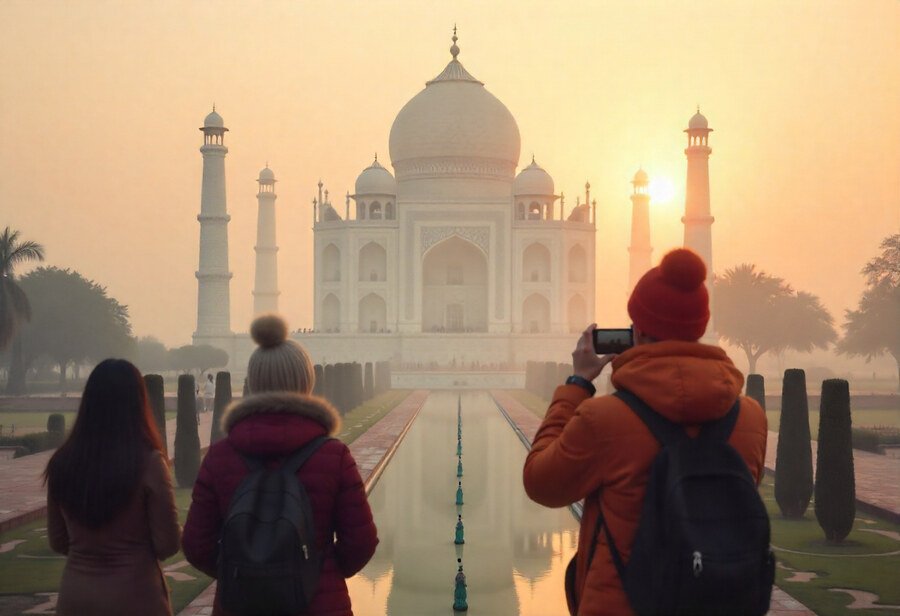Travel Guides & Articles
India Hits 99.52 Lakh Foreign Tourist Arrivals in 2024 but Must Improve Tourism Infrastructure to Unlock Its Full Potential and Compete with Leading Global Destinations

Published on
August 18, 2025
India’s tourism sector has seen a strong recovery in 2024, with foreign tourist arrivals (FTAs) reaching 99.52 lakh, surpassing pre-pandemic levels and signaling a revitalized industry. While the numbers are encouraging, the country faces ongoing challenges in achieving its full tourism potential, particularly when compared to smaller countries that attract higher volumes of international visitors.
A Remarkable Growth in Foreign Tourist Arrivals
- Total Foreign Tourist Arrivals (FTAs): 99.52 lakh
- Leading Source Markets: United States, Bangladesh, United Kingdom, Australia, Canada, Malaysia, Sri Lanka, Germany, France, and Singapore
- International Tourist Arrivals (ITAs): 205.69 lakh in 2024, showing an impressive rise from 63.37 lakh in 2020.
India’s tourism sector has shown an upward trajectory, with the United States and Bangladesh leading as primary sources of foreign visitors. The jump in FTAs from 27.45 lakh in 2020 to 99.52 lakh in 2024 reflects a steady recovery post-pandemic. Additionally, the surge in international tourist arrivals (ITAs) indicates the growing global interest in visiting India. However, concerns remain about India’s ability to attract as many international tourists as other countries with smaller populations.
Global Tourism Landscape: India vs. Competitors
India’s tourism performance, though positive, remains below expectations when compared to other countries. Despite a population of 1.4 billion and an abundance of cultural and natural resources, India continues to trail behind in attracting global tourists. For instance, Vietnam, a smaller country in terms of both size and population, welcomed over 17.6 million international tourists in 2024, far surpassing India’s foreign arrivals.
Major cities in Europe, like Paris, receive 25 million international visitors annually, far outstripping the 10 million tourists India attracts each year. This disparity raises questions about why India, with its rich historical, cultural, and natural heritage, isn’t tapping into its full tourism potential.
India boasts 42 UNESCO World Heritage Sites, more than many European countries, but its ability to attract foreign tourists remains limited. While India’s tourism infrastructure continues to improve, the country still struggles to compete with other nations that have made significant investments in promoting tourism.
Bodh Gaya: A Case Study in Untapped Potential
One of the prime examples of India’s untapped tourism potential is Bodh Gaya, located in Bihar, where Lord Buddha attained enlightenment. Despite being one of the most significant pilgrimage sites for Buddhists worldwide, Bodh Gaya saw only 0.25 million foreign visitors in 2024.
The reasons for this relatively low number are rooted in the lack of adequate infrastructure. While India has made strides in enhancing its tourism offerings, many key sites like Bodh Gaya suffer from inadequate facilities. Poor transportation, limited accommodation options, and underdeveloped tourist amenities hinder the ability to attract a global audience.
In contrast, countries that host global spiritual destinations invest heavily in infrastructure, accommodations, and services to create an immersive experience for visitors. India’s failure to provide such infrastructure at significant cultural and religious sites like Bodh Gaya limits the country’s potential as a global tourism hub.
Infrastructure Challenges: A Barrier to Growth
Despite the impressive growth in tourism numbers, India’s infrastructure still needs substantial improvement to match its growing tourism demand. The shortage of hotel rooms, poor connectivity between major tourist destinations, and inadequate services at key sites like Bodh Gaya have created significant barriers to attracting more international tourists.
India’s hotel sector lags behind global competitors. While China boasts over 20 million hotel rooms, India has only about 0.2 million, limiting its capacity to host a large influx of international travelers. Enhancing this infrastructure, particularly in regions with high tourist demand, is vital to the country’s success in the global tourism industry.
Moreover, India’s visa policies, while streamlined in recent years, still pose challenges. Making visa processes more accessible and convenient for tourists could help increase arrivals, especially from countries where securing a visa is complicated.
Strategic Solutions for Tourism Growth
India must focus on addressing these infrastructure gaps to tap into the full potential of its tourism sector. Investing in hotel accommodations, enhancing transportation networks, and improving facilities at popular tourist destinations will be crucial. This includes upgrading airports, expanding rail networks, and improving road connectivity to make it easier for international visitors to explore the country.
Promoting lesser-known destinations in addition to famous spots like the Taj Mahal can help spread tourism benefits across the country, benefiting regional economies and reducing the pressure on overcrowded tourist hotspots. Additionally, better marketing strategies to promote India’s unique cultural heritage and diverse tourist offerings will be essential in attracting a broader audience.
The government must also prioritize the development of spiritual and religious tourism. Sites like Bodh Gaya, Varanasi, and other cultural landmarks have immense potential but require significant investment in infrastructure to meet the demands of international tourists.
India’s Cultural Heritage: A Key Advantage
India’s cultural heritage remains one of its greatest strengths. With a rich tapestry of languages, traditions, festivals, and cuisines, the country has the power to captivate tourists from around the world. By promoting its diverse cultural experiences, India can differentiate itself in the highly competitive global tourism market.
India is home to a variety of tourist experiences, from the serene backwaters of Kerala to the vibrant streets of Jaipur, offering something for every traveler. However, India must ensure that these experiences are accessible, well-promoted, and provide international visitors with a seamless journey.
Conclusion: A Bright Future for India’s Tourism
The growth of India’s tourism industry in 2024 demonstrates the country’s potential as a global tourist destination. However, to truly unlock this potential, India must focus on addressing its infrastructure challenges, improving accessibility, and enhancing the tourist experience. With its rich cultural heritage and growing international interest, India has the capacity to become a leading player in the global tourism market. By focusing on sustainable development, improving facilities, and leveraging its unique offerings, India can ensure a prosperous future for its tourism sector.
Travel Guides & Articles
Tourism Minister unveils modernised yatrinivas, boosts AP tourism

Andhra Pradesh Tourism Minister Kandula Durgesh announced that the State has attracted nearly INR 12,000 crore in tourism sector investments over the past year. These investments have supported the construction and upgrading of multiple tourist facilities across Andhra Pradesh, aimed at boosting visitor numbers and improving infrastructure. Speaking at the inauguration of the modernised Andhra Pradesh Tourism Development Corporation (APTDC) Haritha Hotel, popularly known as Yatrinivas, at Appughar, he outlined the State’s vision for a more vibrant tourism sector.
The newly renovated Yatrinivas has been given a major facelift, featuring air-conditioned suites, deluxe and executive rooms, a bar, a restaurant, and a meeting hall. The Minister revealed that INR 13.5 crore had been invested to modernise the property, which now boasts 41 rooms equipped with state-of-the-art facilities. He emphasised that such projects are part of a broader government plan to upgrade hotels and resorts across the State to meet the needs of both domestic and international tourists.
Following the inauguration, Durgesh inspected the new facilities at Yatrinivas and expressed optimism that these upgrades would significantly improve the tourist experience. He also visited Tyda and Jungle Bells Resorts in Ananthagiri mandal, Alluri Sitharama Raju district, pointing out that these sites had suffered from neglect under the previous government. According to him, the tourism and forest departments are now collaborating to revitalise these locations and restore their appeal.
The Minister further noted that the Union government is extending substantial support for tourism development in Andhra Pradesh. Key pilgrimage destinations such as Annavaram and Simhachalam are being improved, with a focus on providing better accommodation for devotees. Additionally, the government is prioritising the development of scenic tribal areas like Lambasingi and Vanjangi, with assistance from Central schemes, to attract more visitors and boost local economies.
Durgesh was critical of the previous administration, accusing it of failing to utilise the State’s rich tourism potential. He claimed that such inaction led to missed opportunities for growth and job creation. In contrast, he asserted that the current coalition government, under the leadership of Chief Minister Chandrababu Naidu and Deputy Chief Minister K. Pawan Kalyan, is actively working to revitalise the industry and create employment opportunities for the youth.
Earlier in the day, the Minister inaugurated a Tourism CRW Counter at RK Beach in Visakhapatnam. This facility will allow tourists to book tickets for hop-on-hop-off double-decker buses operating between RK Beach and Totlakonda. He expressed confidence that improved accessibility, modernised infrastructure, and coordinated promotional efforts will position Andhra Pradesh as a leading tourism destination in India.
Travel Guides & Articles
India’s aviation sector set for long-term growth: CareEdge

CareEdge Ratings has stated that despite short-term challenges, the Indian aviation sector is well-positioned for long-term growth. The optimism is driven by favourable demographics, a supportive regulatory environment, rising non-aeronautical revenue per passenger, and expanding city-side airport development. Passenger traffic is projected to grow from 412 million in 2024–25 to 470 million by 2026–27, showing strong underlying demand.
India is now the third-largest aviation market in the world, behind only the United States and China. Airports across the country continue to maintain a steady share of global passenger traffic, which CareEdge sees as evidence of deep structural demand. This stability is expected to encourage further investment in capacity expansion and infrastructure upgrades.
Supportive policies have created a conducive climate for private sector participation in airport development. Long-term investment prospects are strengthened by a young population, an expanding middle class, and a growing appetite for travel—factors that continue to drive consistent passenger growth.
Non-aeronautical revenue streams such as retail, food and beverage, parking, and other commercial services are also rising steadily. This trend is helping improve profitability for airport operators while reducing reliance on aeronautical charges, making the business model more sustainable.
City-side development is emerging as a major opportunity for the sector. Real estate, hospitality, logistics, and commercial spaces around airports are transforming them into integrated urban hubs, unlocking significant long-term value and attracting diverse forms of investment.
Rajashree Murkute, Senior Director at CareEdge Ratings, noted that India’s aviation sector is in a transformative phase as one of the fastest-growing air passenger markets globally. She said that strategic investments in infrastructure, combined with growth in related sectors such as roads, ports, and renewable energy, will not only boost GDP and urbanisation but also strengthen resilience and sustainability in the years ahead.
Travel Guides & Articles
Now, Google Launches AI-Powered Flight Deals to Help Travelers Find the Best Bargains Across the U.S., Canada, and India – Travel And Tour World
-

 Business4 days ago
Business4 days agoThe Guardian view on Trump and the Fed: independence is no substitute for accountability | Editorial
-
Tools & Platforms3 weeks ago
Building Trust in Military AI Starts with Opening the Black Box – War on the Rocks
-

 Ethics & Policy1 month ago
Ethics & Policy1 month agoSDAIA Supports Saudi Arabia’s Leadership in Shaping Global AI Ethics, Policy, and Research – وكالة الأنباء السعودية
-

 Events & Conferences3 months ago
Events & Conferences3 months agoJourney to 1000 models: Scaling Instagram’s recommendation system
-

 Jobs & Careers2 months ago
Jobs & Careers2 months agoMumbai-based Perplexity Alternative Has 60k+ Users Without Funding
-

 Funding & Business2 months ago
Funding & Business2 months agoKayak and Expedia race to build AI travel agents that turn social posts into itineraries
-

 Education2 months ago
Education2 months agoVEX Robotics launches AI-powered classroom robotics system
-

 Podcasts & Talks2 months ago
Podcasts & Talks2 months agoHappy 4th of July! 🎆 Made with Veo 3 in Gemini
-

 Education2 months ago
Education2 months agoAERDF highlights the latest PreK-12 discoveries and inventions
-

 Education2 months ago
Education2 months agoMacron says UK and France have duty to tackle illegal migration ‘with humanity, solidarity and firmness’ – UK politics live | Politics






















